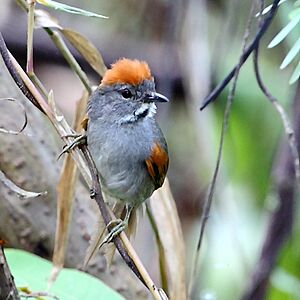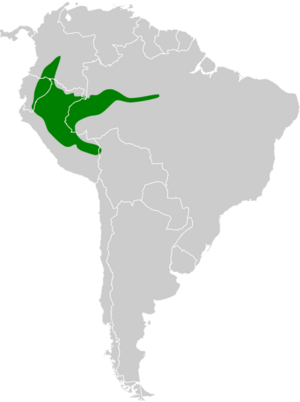Dark-breasted spinetail facts for kids
Quick facts for kids Dark-breasted spinetail |
|
|---|---|
 |
|
| At Iranduba, Amazonas state, Brazil | |
| Conservation status | |
| Scientific classification | |
| Genus: |
Synallaxis
|
| Species: |
albigularis
|
 |
|
The dark-breasted spinetail (its scientific name is Synallaxis albigularis) is a type of bird. It belongs to the ovenbird family called Furnariidae. You can find this bird in several South American countries. These include Bolivia, Brazil, Colombia, Ecuador, and Peru.
Contents
Meet the Dark-breasted Spinetail
What Does It Look Like?
The dark-breasted spinetail is a small bird, about 15 to 16 centimeters (6 inches) long. It weighs between 14 and 18 grams, which is about half an ounce. Both male and female birds look the same.
Adult birds have a brownish-gray face and the front part of their head. The back of their head and neck are a dark reddish-brown color. Their back and rump are olive-brown. Their wings are dark reddish-brown with lighter edges. Their tail is dull brown and has pointed tips.
Their throat is grayish-white with some dark spots. The lower part of their throat has blackish feathers with light gray edges. Their chest and sides are brownish-gray. Their belly is lighter gray, almost white in the middle. Their legs and feet are usually greenish-gray or greenish-yellow.
Young spinetails have a brownish-gray head. Their underparts are mostly dark yellowish-brown. Their throat patch is lighter and not as clear as in adult birds.
Different Types of Spinetails
There are two main types, or subspecies, of the dark-breasted spinetail. One is called S. a. albigularis and the other is S. a. rodolphei. The rodolphei subspecies has a slightly darker back. Its underparts are much darker than the other type, except for a very white belly center.
Where Do Spinetails Live?
The S. a. rodolphei subspecies lives in south-central Colombia and extends south into northeastern Ecuador. The other subspecies, S. a. albigularis, is found from Ecuador and southern Colombia. It spreads south through eastern Ecuador and Peru into western Bolivia. It also lives east in Brazil along the Amazon River.
These birds like to live in places with tall grass, bushes, and cane plants. You can often find them on river islands. They also live in shrubby clearings, pastures, and even plantations. They usually live from sea level up to about 1,500 meters (4,900 feet) high. Sometimes, they can be found as high as 2,100 meters (6,900 feet).
How Do Spinetails Behave?
Staying in One Place
The dark-breasted spinetail stays in the same area all year round. It does not migrate.
What Do They Eat?
These birds mostly eat arthropods, which are creatures like insects and spiders. They usually hunt for food in pairs. They pick their prey off leaves and small branches. They typically stay about 1 to 2 meters (3 to 7 feet) above the ground while foraging. They also look for food on the ground.
Building Nests and Raising Young
In Colombia, the dark-breasted spinetail's breeding season happens in June and July. Scientists believe these birds stay with one partner for life.
Their nest is a big pile of sticks. It has a tube-like entrance on the side. They usually build their nests in thick plants, about 1 to 2 meters (3 to 7 feet) off the ground. Not much else is known about how they raise their young.
What Sounds Do They Make?
The dark-breasted spinetail has a special song. It sounds like a fast "chéép, du-du-du" or "whít, di-di-di." They often repeat this song many times. They also make other sounds, like a short "chatter" and a fast "whinny" that sounds like "neeh-neeh-neeh-neeh-neh-neh-neh."
Is the Spinetail Safe?
The IUCN (International Union for Conservation of Nature) says the dark-breasted spinetail is a species of "Least Concern." This means it is not currently in danger of disappearing. It lives in a very large area. We don't know exactly how many there are, but their numbers seem to be growing. There are no immediate threats to this bird. It is quite common and lives in several protected areas. It can even be found in places where humans have changed the land, and it is expanding into areas where forests have been cut down.


